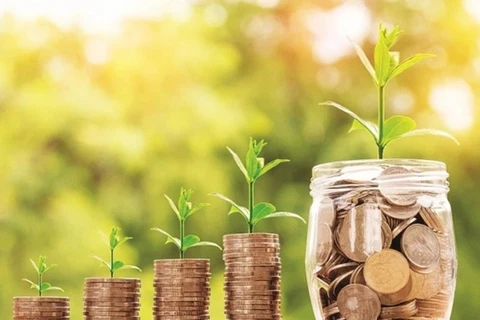Hanoi (VNA) – Bank capital is considered the "lifeblood" and is extremely important in promoting the country's socioeconomic development. In the context that Vietnam is promoting the development of industries toward green growth, "green credit" contributes to supporting businesses to develop sustainably.
Acknowledging the importance of green credit, the State Bank of Vietnam (SBV) issued Directive No 3/CT-SBV dated March 24, 2015, which requires commercial banks to promote green credit for environmental protection projects and encourages environmentally friendly business activities.
The total green credit balance topped nearly 528.3 trillion VND ( 22.3 billion USD) by June 30, 2023, accounting for 4.2% of the total outstanding loans of the economy, compared with nearly 85 trillion VND or 1.5% in 2016.
Among the 12 green fields that the SBV guides credit institutions to lend, outstanding loans focus mainly on renewable energy, clean energy (accounting for 45%), and green agriculture (31%).
According to Nguyen Quoc Hung, Vice President and General Secretary of the Vietnam Banks Association, greening the economy is a global trend and is receiving attention on international agendas to minimise negative impacts of economic growth on the environment and society.
Green credit and green banking play an important role in implementing the National Green Growth Strategy in the 2021-2030 period with a vision to 2050 as they create resources for environmentally friendly projects and programmes.
 The State Bank of Vietnam (SBV) asks commercial banks to promote green credit for environmental projects and environmentally friendly business activities. (Photo: VietnamPlus)
The State Bank of Vietnam (SBV) asks commercial banks to promote green credit for environmental projects and environmentally friendly business activities. (Photo: VietnamPlus) Tran Anh Quy, head of Policy Credit at SBV’s Department of Credit for Economic Sectors, said the SBV has directed credit institutions to implement green credit programmes targeting some industries such as green agriculture, forestry, housing, and environment.
During 2018-2019, the SBV coordinated with the International Finance Corporation (IFC) to issue a handbook on social and environmental risk assessment for 15 economic sectors. The book is a toolkit to help banks assess the environmental and social risks of credit projects and assist credit officers in appraising business plans, ensuring effective green and sustainable development.
The SBV has collaborated with the Ministry of Natural Resources and Environment to develop and submit to the Prime Minister for approval a green classification list, which will facilitate the deployment of green financing activities of credit institutions.
It has also studied and developed mechanisms and policies as well as projects to expand modern banking services with the application of high technology, contributing to boosting green growth.
Promoting green credit for sustainable development
Phan Thanh Hai, Deputy General Director of BIDV, said the bank began to lend to green projects early, especially those relating to renewable energy.
BIDV has focused on investing in wind and solar power projects since 2013 and it has also included green growth strategy in its business strategy.
As of September 30, 2023, BIDV funded 1,500 customers with 1,900 green credit projects, with total outstanding loans of more than 71 trillion VND, or 5.5% of total outstanding loans of BIDV, up 11% year-on-year.
 Agribank will also build a green economy, a circular, and environmentally friendly economy.(Photo: VietnamPlus)
Agribank will also build a green economy, a circular, and environmentally friendly economy.(Photo: VietnamPlus) Nguyen Thi Thu Ha - head of the Financial Institutions Department of Vietnam Bank for Agriculture and Rural Development (Agribank) said nearly 70% of Agribank’s outstanding loans are in the field of agriculture and rural development, so developing green credit is very important to it.
Besides the above-mentioned banks, other credit organisations have also joined the green credit segment, but the disbursement amount was still modest due to the lack of a clear legal framework./.

























